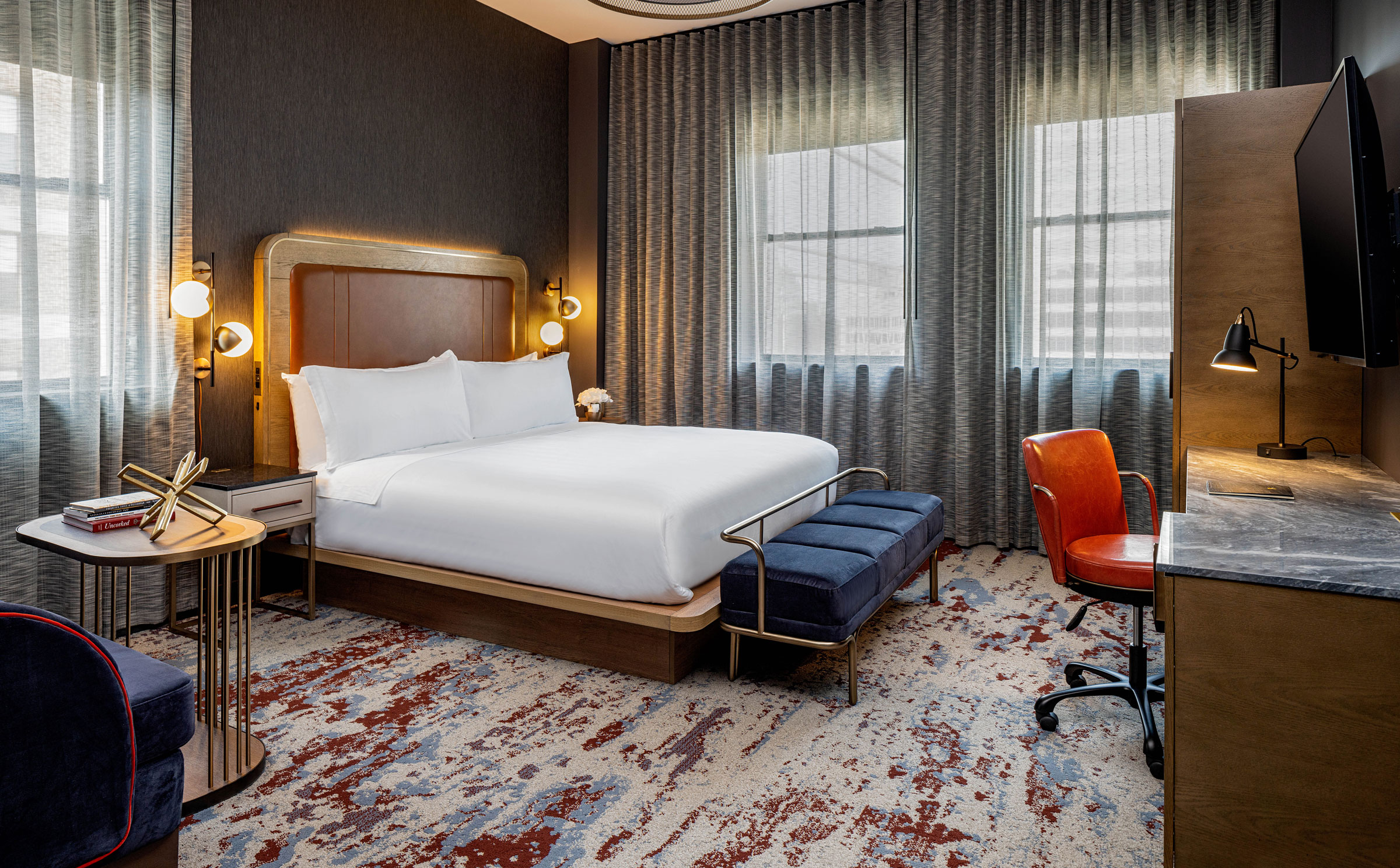Story at a glance:
- The Industrialist hotel is part of Marriott International’s Autograph Collection and was inspired by Pittsburgh’s history in the steel industry.
- The adaptive reuse project revives a 1902 building with a smoky color palette, LED lights, and upgraded building systems.
Steps from Point State Park and the confluence of the Allegheny, Monongahela, and Ohio rivers, the Industrialist Hotel is a beautiful example of adaptive reuse in a city that has also reinvented itself in recent decades—Pittsburgh.
Adaptive reuse expands on what already makes Marriott’s Autograph Collection special, as it’s described as a “global collection of distinctive independent hotels carefully crafted to leave a lasting imprint.”
The Industrialist in the historic Arrott Building is an 18-story landmark originally built in 1902, designed by architect Frederick Osterling in Pittsburgh’s prominent 4th Avenue District.
“The building is well located in the heart of Pittsburgh’s Golden Triangle,” says Kirsten Vaselaar, senior vice president of real estate and development at HRI Properties.
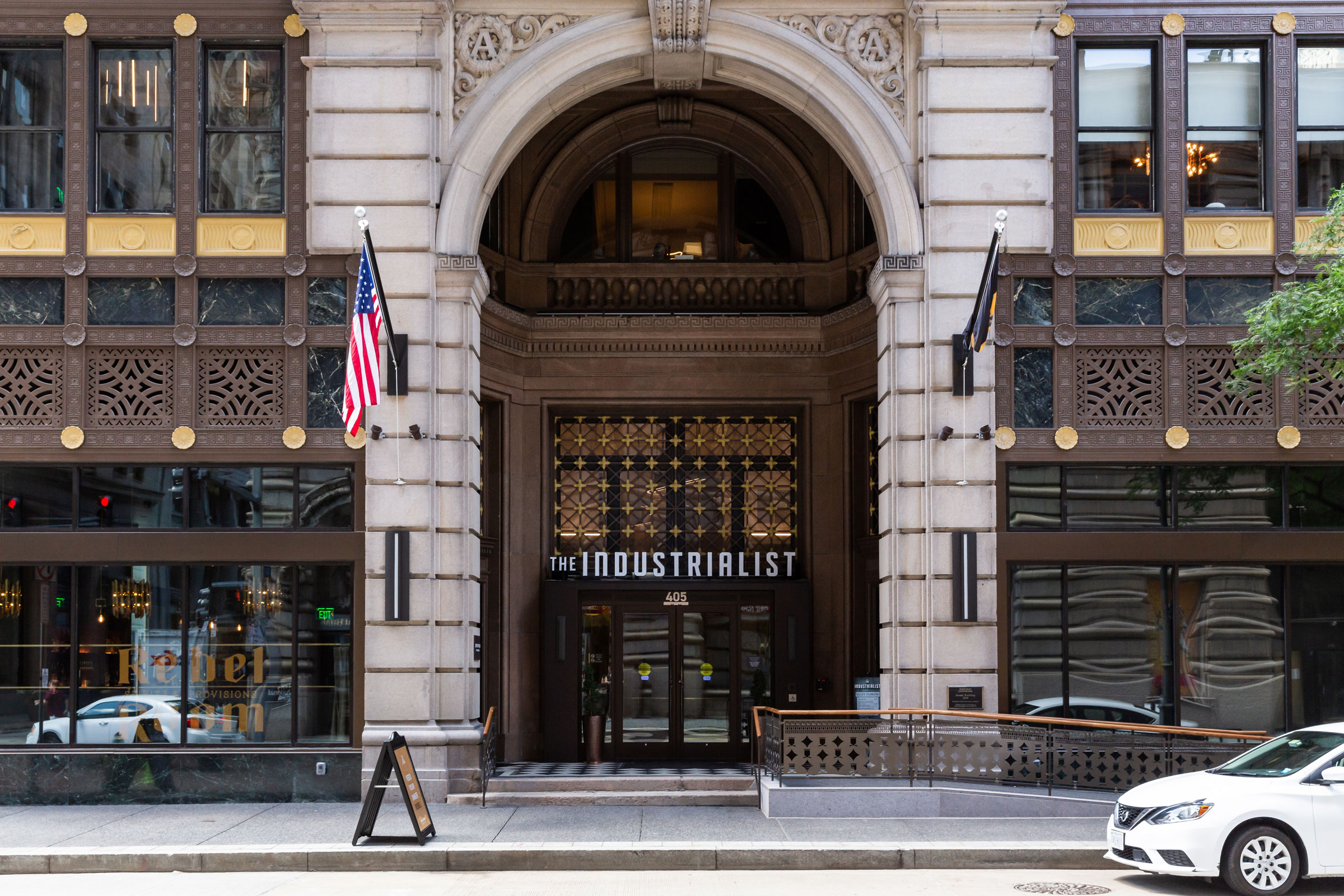
The Industrialist Hotel’s historic facade holds rich architectural details, including a Cornice crown with howling masks and a brick and terra-cotta–striped facade on a granite base. The design team completed significant restoration work at the building’s cornice, repairing and replacing structural steel that had been compromised by water infiltration. Photo by Digital Love Studios
She says key business drivers in the immediate area—including corporate headquarters, sporting events, and Point Park University—added to the building’s appeal. And because it is a contributing building to the National Register Fourth Avenue Historic District, the building qualified for the Federal Historic Tax Credit program, which assists owners in the rehabilitation of historic buildings.
“The adaptive reuse of a historic building can help set the stage for the brand’s pillars for creating a unique and local experience for guests,” Vaselaar says. “While not a requirement of the brand, a grand historic building with significant original features intact will certainly elevate the hotel’s interior design and storytelling.”

The hotel’s interior design references the thriving history of Pittsburgh as an industrial capital, harkening back to its days in the steel industry. Design-forward brass wall sconces frame the area against a monochromatic wall. Smoke-like abstract artworks hang next to each bed. Plush modern sofas highlighted by orange piping are found in the corresponding seating areas paired with a metal and wood C-tables/desks. Photo courtesy of The Industrialist
Stonehill Taylor gave the 124-room hotel its stunning new interior design, seamlessly blending old and new across three floors of public spaces as well as all guestrooms and suites. Historic finishes and features stand out on the first and second floors, as they were preserved and highlighted in the finished project.
“The first-floor lobby is my favorite historic element,” Vaselaar says. “It had been well cared for by the previous owners and is almost entirely unaltered from its original construction.”
To reinterpret the imposing space as a hotel entrance, the team modernized the light fixtures and created new openings into the first-floor Rebel Room restaurant and bar and the bathroom corridor.
The entry to the hotel is located on the first floor, where guests will walk into a historic grand elevator lobby clad in original marble walls, floors, and brass accents from the turn of the century. Custom modern lighting guides guests to the elevators, and up-lit walls create a unique special effect on the ornate ceiling reminiscent of the city’s nearby rivers. The focal point of the elevator lobby is a collection of three modern sculptural chandeliers made of metal and inspired by machinery and steel fabrication.
On the second floor, the original ceiling in the lounge was not obscured by HVAC ducting and vents to maintain the original experience of this space. Instead, the HVAC equipment and ductwork supplying the lounge were installed below the floor.
“The greenest building is the one that already exists,” Vaselaar says. “By giving the building a new use, bringing it up to code, upgrading all of the building systems, repairing the exterior envelope as needed, and installing a new roof, the project has helped ensure that this building can continue to perform, serve an economic purpose, and contribute to the community for many years to come.”

The Rebel Room restaurant and bar is illuminated by large original windows facing the street. The bar is the focal point, with glowing features imitating a large hearth with warm backlighting, copper mesh coverings, and a back-lit outsized antique mirror TV and two-toned patina bar top reminiscent of molten steel. The banquette railings and tables feature brass accents and subdued dark upholstery keeping the focus on the bar. Water inspired blue porcelain tiles underneath the bar top add contrast and soften the space. Photo courtesy of The Industrialist
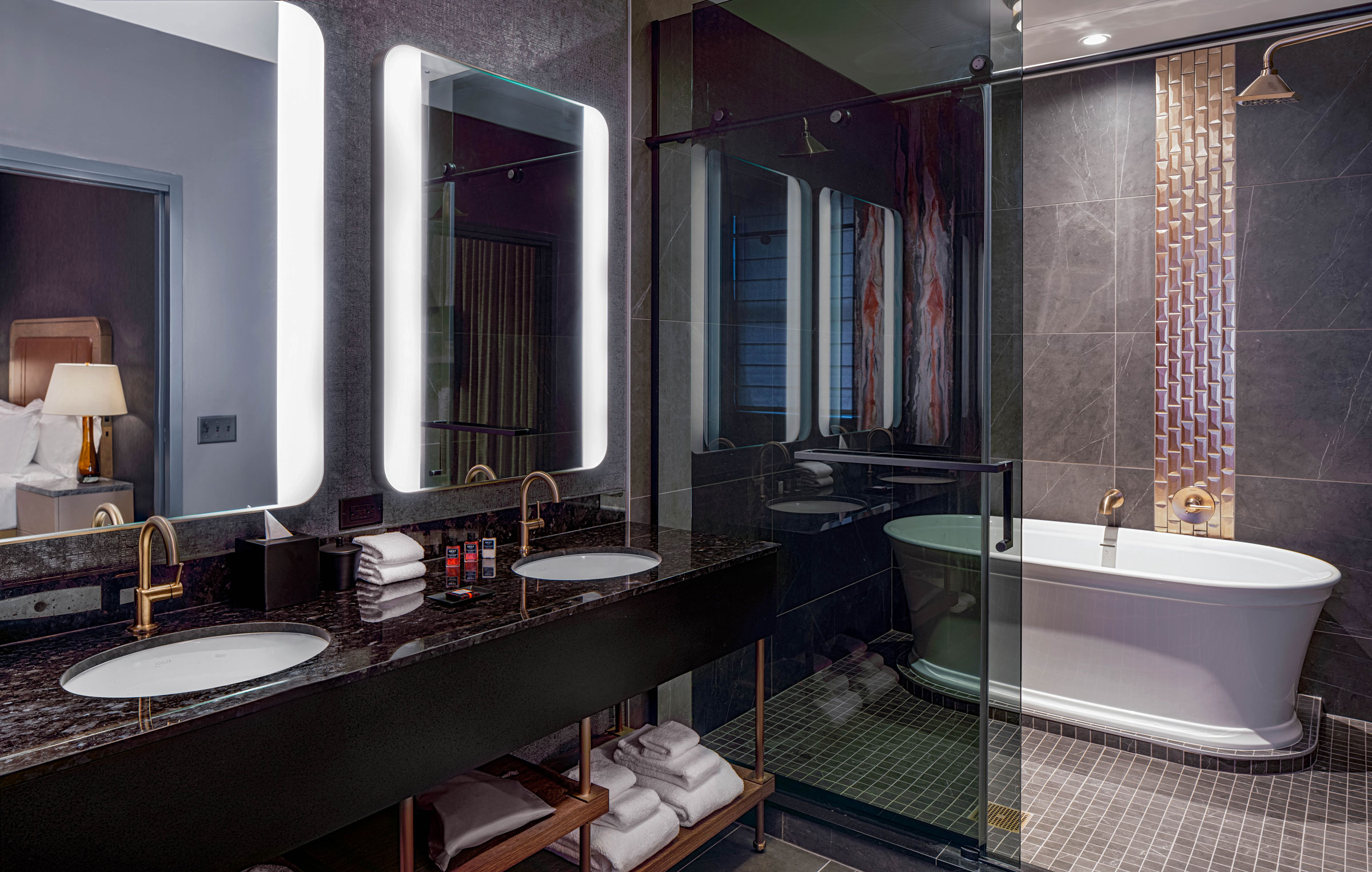
The Presidential Suite was designed to be a great suite experience—including a great bathroom. The bath was oriented to capture natural light and to allow space for a double vanity and great wet room. The hotel is in the historic Arrott building, named for James Arrott─known as the “Bathtub King of Pittsburgh” for being the first in the region to offer enameled iron bathtubs through his manufacturing business. Photo courtesy of The Industrialist
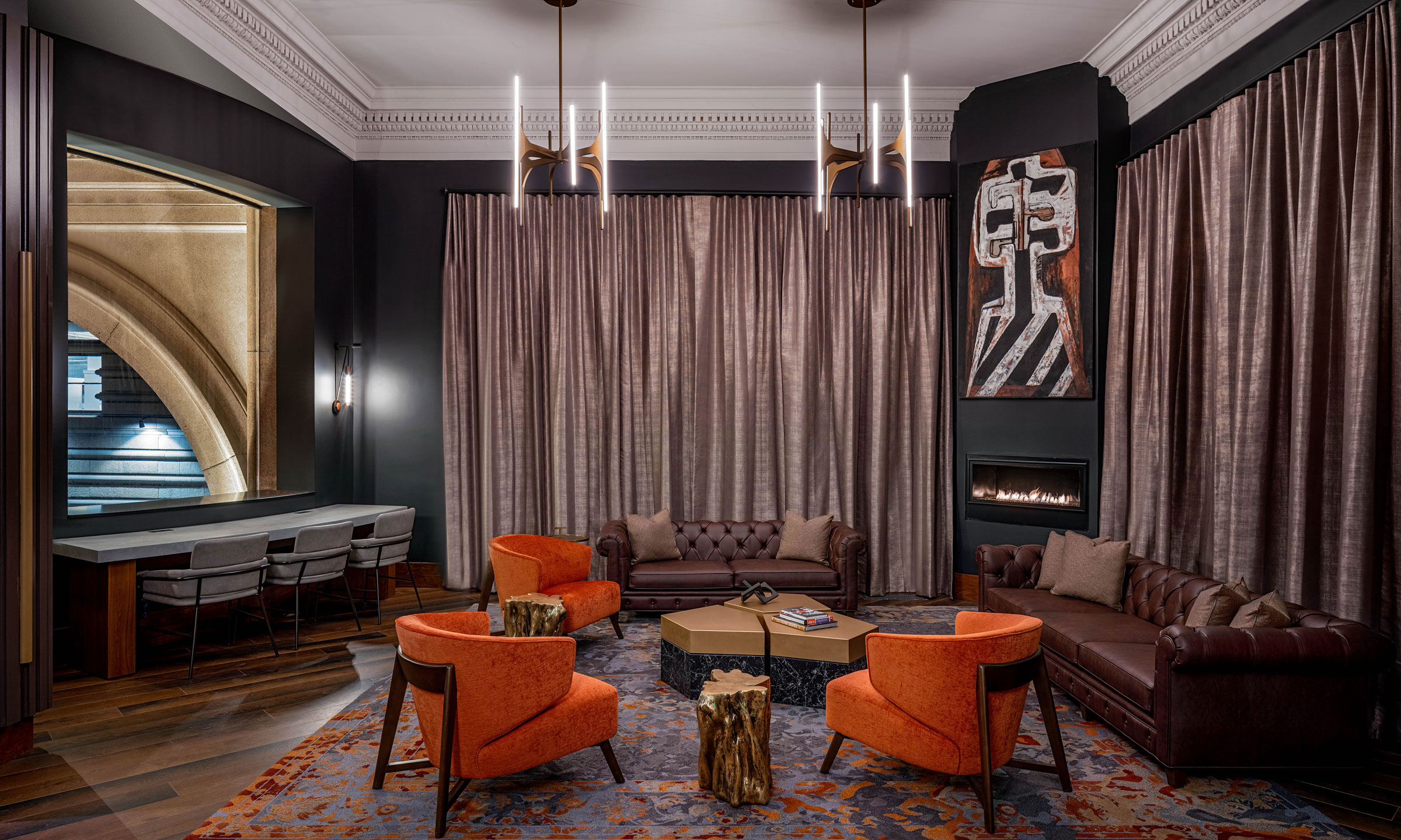
The salon invites visitors to relax in one of the custom burnt orange Moderna chairs or classic plush sofas around a striking corner fireplace clad in antique mirror underneath a statement artwork by Pittsburgh artist Louise Pershing. This space features modern brass lighting as well as brass side and coffee tables, which sit atop a custom molten-inspired rug. Photo courtesy of The Industrialist
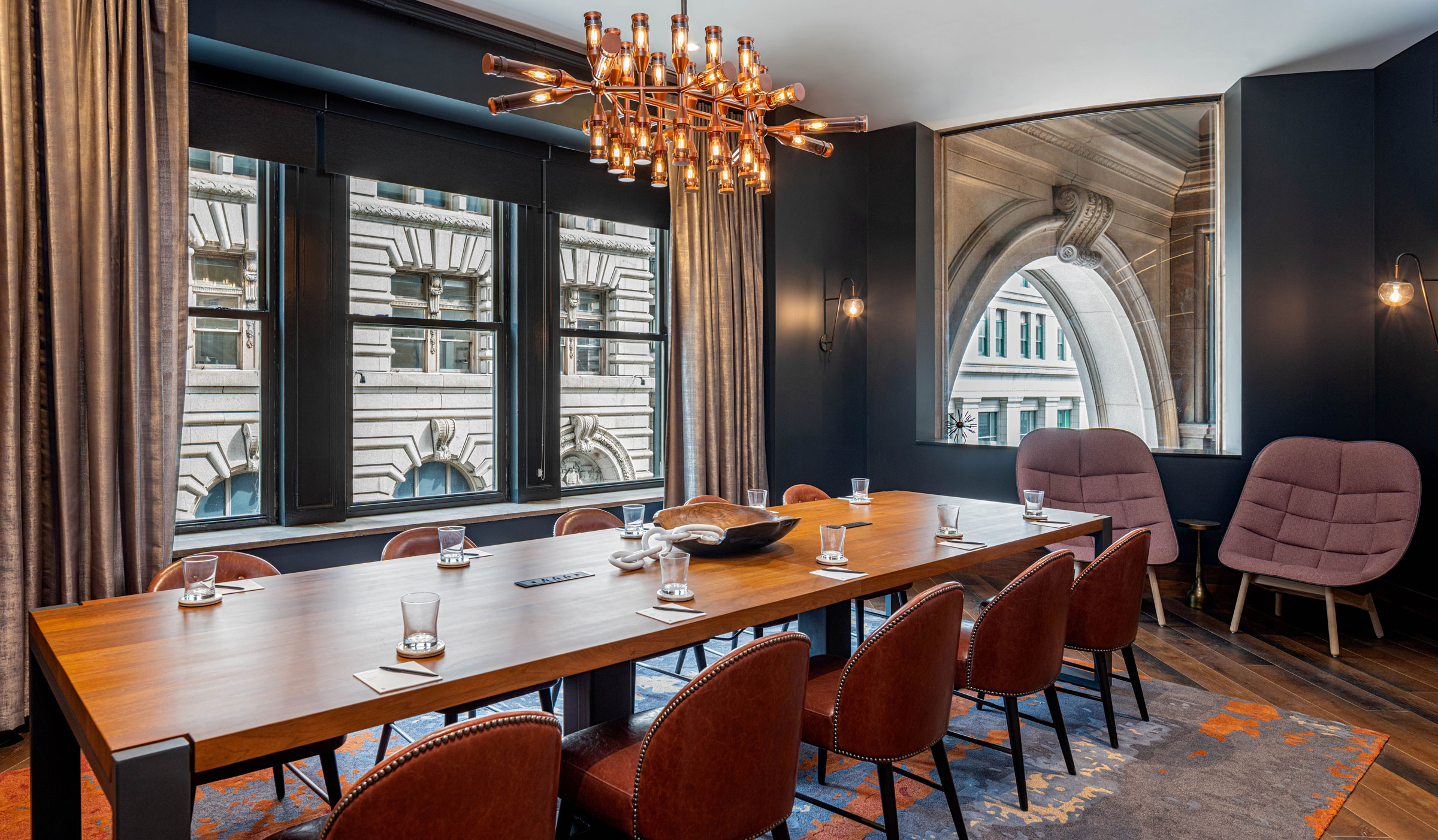
Stonehill Taylor gave the 124-room hotel its stunning new interior design, blending old and new across three floors of public spaces as well as guestrooms and suites. Historic finishes and features stand out on the first and second floors, as they were preserved and highlighted in the finished project. Photo courtesy of The Industrialist
Project Credits
Project: The Industrialist
Location: Pittsburgh
Completion: May 2021
Architect: Desmone Architects
Interior Design: Stonehill Taylor
Lighting: Mix by Trinity Lighting
Guestroom Flooring: Shaw Industries

